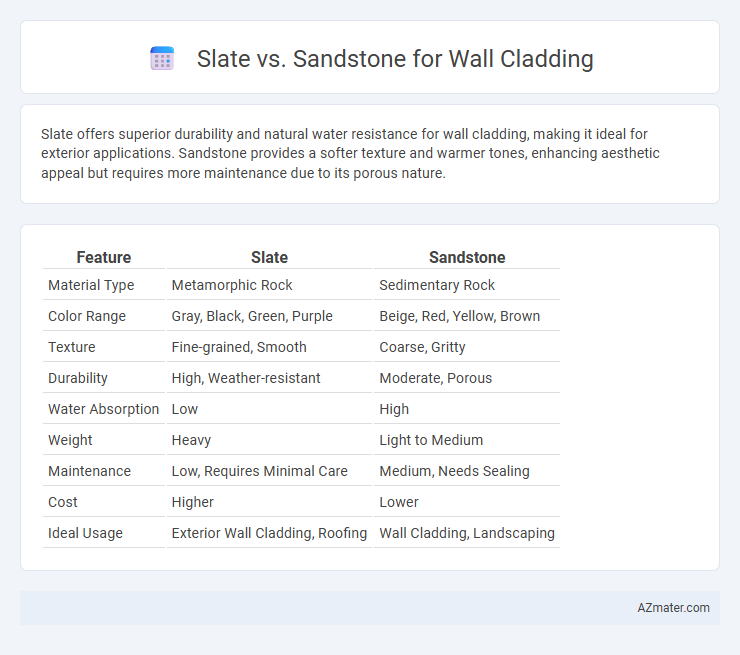Slate offers superior durability and natural water resistance for wall cladding, making it ideal for exterior applications. Sandstone provides a softer texture and warmer tones, enhancing aesthetic appeal but requires more maintenance due to its porous nature.
Table of Comparison
| Feature | Slate | Sandstone |
|---|---|---|
| Material Type | Metamorphic Rock | Sedimentary Rock |
| Color Range | Gray, Black, Green, Purple | Beige, Red, Yellow, Brown |
| Texture | Fine-grained, Smooth | Coarse, Gritty |
| Durability | High, Weather-resistant | Moderate, Porous |
| Water Absorption | Low | High |
| Weight | Heavy | Light to Medium |
| Maintenance | Low, Requires Minimal Care | Medium, Needs Sealing |
| Cost | Higher | Lower |
| Ideal Usage | Exterior Wall Cladding, Roofing | Wall Cladding, Landscaping |
Introduction to Slate and Sandstone Wall Cladding
Slate wall cladding offers a dense, fine-grained texture with natural cleavage, providing exceptional durability and a sophisticated, layered appearance ideal for both exterior and interior surfaces. Sandstone wall cladding features a sedimentary composition with a granular texture, delivering warm tones and a softer, rustic aesthetic that enhances natural architectural elements. Both materials provide excellent weather resistance and unique visual appeal, making them popular choices for enhancing structural facades and creating distinctive wall designs.
Geological Origins and Composition
Slate and sandstone differ significantly in geological origins and composition, impacting their suitability for wall cladding. Slate is a fine-grained metamorphic rock formed from shale under intense heat and pressure, giving it a dense, durable structure with natural cleavage planes ideal for thin, flat panels. Sandstone, a sedimentary rock composed mainly of compacted sand-sized quartz or feldspar grains, displays a more porous and variable texture that influences its weather resistance and aesthetic appeal in architectural applications.
Appearance and Color Variations
Slate offers a sleek, fine-grained texture with natural cleft surfaces, presenting deep, rich colors such as dark gray, green, purple, and black, creating a sophisticated and contemporary look for wall cladding. Sandstone exhibits a coarser, more granular appearance with warm earthy tones like beige, red, yellow, and brown, providing a rustic and natural aesthetic ideal for enhancing outdoor and traditional designs. The color variations of slate tend to be cooler and more uniform, while sandstone features warmer, more varied hues that evolve with weathering and exposure.
Durability and Weather Resistance
Slate offers superior durability and weather resistance compared to sandstone, making it ideal for wall cladding in harsh climates. Its dense, fine-grained composition resists moisture penetration and erosion, ensuring long-lasting performance. Sandstone, while aesthetically pleasing, is more porous and prone to weathering, requiring regular maintenance to preserve its structural integrity.
Installation Methods and Processes
Slate wall cladding requires precise cutting and often mechanical fastening with stainless steel clips or anchors to accommodate its natural cleavage and prevent cracking during installation. Sandstone cladding typically involves adhesive bonding or mortar bedding, benefiting from its generally softer texture and easier manipulation on-site. Both materials need proper substrate preparation and waterproofing to ensure long-term durability, but slate's denser composition demands more careful handling and specialized tools compared to sandstone.
Maintenance and Long-Term Care
Slate wall cladding requires minimal maintenance due to its natural resistance to water, stains, and weathering, making it ideal for long-term durability with only occasional cleaning and sealing every few years. Sandstone, being more porous and softer, demands more frequent sealing and protection from moisture to prevent erosion and discoloration, leading to higher long-term maintenance efforts. Choosing slate over sandstone reduces upkeep costs and preserves aesthetic appeal longer in exterior wall cladding applications.
Cost Comparison and Budget Considerations
Slate wall cladding typically demands higher upfront costs due to its durability, natural texture, and complex quarrying process, making it a premium choice for project budgets. Sandstone offers a more budget-friendly alternative with moderate pricing, easier sourcing, and simpler installation, which suits cost-sensitive renovations or large-scale applications. Evaluating long-term maintenance expenses, slate's resistance to weathering can reduce upkeep costs, while sandstone may require periodic sealing to maintain its appearance, impacting overall budget planning.
Environmental Impact and Sustainability
Slate for wall cladding offers a low environmental impact due to its natural durability and minimal processing requirements, resulting in less energy consumption and reduced carbon emissions. Sandstone, while also natural, often requires more extensive quarrying and processing, leading to higher environmental disruption and energy use. Both materials are recyclable and biodegradable, but slate's longer lifespan and resistance to weathering make it a more sustainable choice for eco-conscious construction projects.
Ideal Applications for Slate and Sandstone
Slate is ideal for wall cladding in areas requiring high durability and moisture resistance, such as exterior facades and wet environments due to its fine-grained, dense structure. Sandstone suits interior feature walls and decorative facades where a warm, textured appearance is desired, benefiting from its softer, porous composition that allows easier carving and shaping. Both materials offer distinct aesthetic and functional advantages depending on environmental exposure and design requirements.
Choosing the Best Material for Your Project
Slate offers superior durability and a natural, elegant appearance ideal for exterior wall cladding, especially in harsh weather conditions. Sandstone provides a warmer, softer texture with excellent versatility and breathability, making it suitable for both interior and exterior applications. Selecting the best material depends on project requirements such as climate resilience, aesthetic preference, and maintenance considerations.

Infographic: Slate vs Sandstone for Wall Cladding
 azmater.com
azmater.com